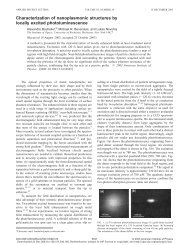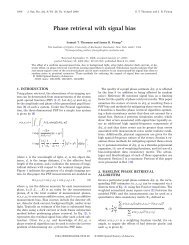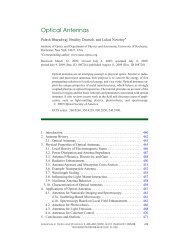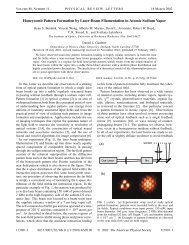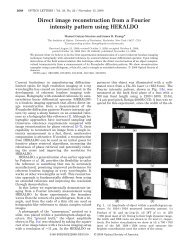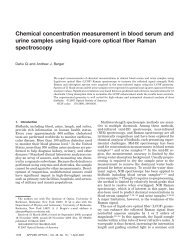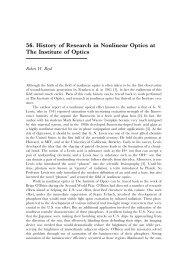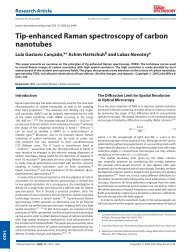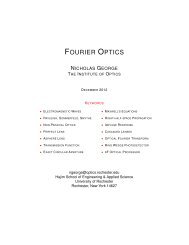Optical Frequency Mixing at Coupled Gold Nanoparticles
Optical Frequency Mixing at Coupled Gold Nanoparticles
Optical Frequency Mixing at Coupled Gold Nanoparticles
Create successful ePaper yourself
Turn your PDF publications into a flip-book with our unique Google optimized e-Paper software.
PRL 98, 026104 (2007)<br />
PHYSICAL REVIEW LETTERS week ending<br />
12 JANUARY 2007<br />
<strong>Optical</strong> <strong>Frequency</strong> <strong>Mixing</strong> <strong>at</strong> <strong>Coupled</strong> <strong>Gold</strong> <strong>Nanoparticles</strong><br />
M<strong>at</strong>thias Danckwerts and Lukas Novotny*<br />
Institute of Optics, University of Rochester, Rochester, New York USA<br />
(Received 20 September 2006; published 10 January 2007)<br />
We present nonlinear-optical four-wave mixing (4WM) <strong>at</strong> coupled gold nanoparticles. By decreasing<br />
the interparticle distance from large separ<strong>at</strong>ion to touching contact, the 4WM yield increases by 4 orders<br />
of magnitude. The reason for this dram<strong>at</strong>ic enhancement lies in the shift of the localized plasmon<br />
resonance to infrared wavelengths as the dimer is formed, making one of the input wavelengths doubly<br />
resonant. At the touching point, the 4WM signal changes discontinuously because of a sudden charge<br />
redistribution imposed by the form<strong>at</strong>ion of a conductive bridge. The 4-wave mixing signal provides an<br />
ultrasensitive measure for the contact point between a pair of particles and it can be employed as a<br />
sp<strong>at</strong>ially and temporally controllable photon source.<br />
DOI: 10.1103/PhysRevLett.98.026104<br />
PACS numbers: 68.37.Uv, 42.65.Ky, 73.20.Mf, 78.67.Bf<br />
Noble-metal particles have received an ever increasing<br />
amount of scientific <strong>at</strong>tention owing to their fascin<strong>at</strong>ing<br />
chemical and optical properties. Their optical response is<br />
governed by the resonant excit<strong>at</strong>ion of surface plasmons,<br />
and therefore depends on particle size, shape, and m<strong>at</strong>erial,<br />
but also on the dielectric environment. <strong>Gold</strong> nanoparticles<br />
conjug<strong>at</strong>ed with specific biomolecules are used for DNA<br />
detection [1], biosensing, and imaging [2,3], and for drug<br />
delivery and cancer tre<strong>at</strong>ment [4,5]. Organic linker molecules<br />
can be employed for self-assembly of more complex<br />
nanostructures such as nanoparticle aggreg<strong>at</strong>es [6], metalsemiconductor<br />
hybrid structures [7], and for particle synthesis<br />
and immobiliz<strong>at</strong>ion [8]. Aggreg<strong>at</strong>es and ordered<br />
arrays of metal nanoparticles are being developed for<br />
controlled waveguiding of surface plasmons [9,10] and<br />
for surface enhanced spectroscopy [11,12].<br />
To enhance the optical specificity of metal nanoparticles,<br />
a large body of research is devoted to tailoring their<br />
linear optical properties [13]. However, metal nanoparticles<br />
also exhibit a strong nonlinear response which is<br />
being applied, for example, in nanoparticle-doped dielectrics<br />
for frequency conversion [14,15]. The nonlinear<br />
susceptibility of the composite depends strongly on interactions<br />
between the particles as the percol<strong>at</strong>ion threshold is<br />
approached [16,17]. So far, most studies of the nonlinear<br />
properties of metal nanoparticles have been performed on<br />
particle ensembles or particle aggreg<strong>at</strong>es. However, ensemble<br />
averaged measurements often obscure important<br />
physical details because of size and shape vari<strong>at</strong>ions as<br />
well as varying local environments and structural defects.<br />
Recent single nanoparticle studies have shown th<strong>at</strong> ensemble<br />
averaging can be overcome and th<strong>at</strong> the<br />
nonlinear-optical properties of individual and interacting<br />
nanoparticles can be measured [18,19].<br />
In this Letter, we show th<strong>at</strong> two near-infrared (NIR) laser<br />
frequencies (! 1 and ! 2 ) can be very efficiently mixed <strong>at</strong> a<br />
pair of gold nanoparticles, yielding visible radi<strong>at</strong>ion <strong>at</strong> the<br />
frequency 2! 1 ! 2 , similar to surface-coherent anti-<br />
Stokes Raman sc<strong>at</strong>tering (CARS) [20]. By controllably<br />
reducing the separ<strong>at</strong>ion between the pair we demonstr<strong>at</strong>e<br />
th<strong>at</strong> the intensity of this four-wave mixing (4WM) signal<br />
can be enhanced by 4 orders of magnitude. Interestingly, <strong>at</strong><br />
larger separ<strong>at</strong>ions the 4WM signal increases continuously<br />
with decreasing separ<strong>at</strong>ion but then, close to touching<br />
contact, abruptly changes to a different distance dependence.<br />
This discontinuity origin<strong>at</strong>es from the spectral jump<br />
of the surface plasmon resonance when the two particles<br />
get into conductive contact [21,22] and it provides an<br />
ultrasensitive optical measure for the contact point. The<br />
dimer acts as a strong emitter of light gener<strong>at</strong>ed by optical<br />
wave mixing; its radi<strong>at</strong>ion is spectrally narrow and well<br />
separ<strong>at</strong>ed from the excit<strong>at</strong>ion. With the dimer being <strong>at</strong>tached<br />
to the end of a glass tip, we show th<strong>at</strong> by scanning<br />
this probe over a sample surface, we can perform highresolution<br />
near-field optical imaging and spectroscopy.<br />
As shown in Fig. 1(a), we use an objective to focus two<br />
linearly polarized laser beams on the surface of a transparent<br />
sample with dispersed gold nanoparticles. The sample<br />
was prepared by spin co<strong>at</strong>ing a colloidal gold nanoparticle<br />
solution onto a glass coverslip which was first functionalized<br />
with (3-mercaptopropyl)trimethoxysilane (MPTMS).<br />
Another gold nanoparticle is <strong>at</strong>tached to the end of an<br />
aminosilane functionalized pointed optical fiber [23,24]<br />
and its rel<strong>at</strong>ive position with respect to the sample and<br />
the excit<strong>at</strong>ion beam is controlled in three dimensions with<br />
subnanometer accuracy using a shear-force feedback<br />
mechanism [25]. The light emitted from the nanoparticles<br />
is collected by the same objective and spectrally separ<strong>at</strong>ed<br />
from the exciting light by a 45 dichroic beam splitter and<br />
other filters. For imaging and spectral analysis, either a<br />
single-photon counting avalanche photodiode (APD) or a<br />
combin<strong>at</strong>ion of spectrometer and CCD detection is used.<br />
For excit<strong>at</strong>ion, a Ti:sapphire laser source produces 180 fs<br />
pulses in the wavelength range of 700–900 nm <strong>at</strong> a repetition<br />
r<strong>at</strong>e of 76 MHz. A part of this light is used to pump an<br />
optical parametric oscill<strong>at</strong>or (OPO) to gener<strong>at</strong>e coherent<br />
pulses in the wavelength range of 1050–1200 nm. The two<br />
beams are combined and expanded to obtain approxi-<br />
0031-9007=07=98(2)=026104(4) 026104-1 © 2007 The American Physical Society
PRL 98, 026104 (2007)<br />
PHYSICAL REVIEW LETTERS week ending<br />
12 JANUARY 2007<br />
(a)<br />
ω 1<br />
ω 2<br />
ω 4wm<br />
450<br />
ω 1+ω 2<br />
500<br />
100nm<br />
550 600 650<br />
wavelength (nm)<br />
2ω 1 -ω 2<br />
FIG. 1 (color online). (a) Sketch of the experiment. The nonlinear<br />
signal <strong>at</strong> frequency 2! 1 ! 2 is measured as a function of<br />
the rel<strong>at</strong>ive position between individual gold nanoparticles.<br />
(b) Emission spectrum from a dimer of two identical particles<br />
(60 nm diameter), excited with pulsed lasers of wavelength 1<br />
830 nm and 2 1185 nm. The superimposed dotted curve<br />
shows the spectrum for two particles of unequal size (60 nm<br />
and 100 nm diameter). The inset shows an SEM image of two<br />
gold particles <strong>at</strong>tached to a pointed optical fiber.<br />
m<strong>at</strong>ely planar wave fronts <strong>at</strong> the back aperture of the<br />
objective. Average input beam powers <strong>at</strong> the back aperture<br />
are on the order of 0.5 mW corresponding to peak intensities<br />
of 1–10 GW=cm 2 <strong>at</strong> the sample.<br />
The nonlinear-optical response of single isol<strong>at</strong>ed gold<br />
particles of 60 nm diameter is very weak for the intensities<br />
used in all our experiments. No significant harmonic gener<strong>at</strong>ion<br />
nor wave mixing was observable; only a small<br />
background of continuum gener<strong>at</strong>ion was measured [26].<br />
This low yield is not surprising given the small source<br />
volume of the nanoparticles and the fact th<strong>at</strong> the input<br />
wavelengths are not resonant with the surface plasmon<br />
resonance of the particles ( 530 nm). However, for a<br />
particle dimer we observe unusually strong four-wave<br />
mixing. A typical emission spectrum from a particle dimer<br />
<strong>at</strong>tached to the end of a glass tip is shown in Fig. 1(b).<br />
Besides a weak continuum background the spectrum exhibits<br />
predominantly one emission line. The intensity of<br />
this line scales quadr<strong>at</strong>ically with the power of the<br />
Ti:sapphire laser and linearly with the power of the OPO<br />
and the spectral position is determined by 2! 1 ! 2 , ! 1<br />
and ! 2 being the laser frequencies of Ti:sapphire and OPO,<br />
respectively. Consequently, this signal origin<strong>at</strong>es from a<br />
third-order polarizability<br />
P 3 2! 1 ! 2<br />
$3: E 1 ! 1 E 1 ! 1 E 2 ! 2 ; (1)<br />
similar to 4WM in nonlinear crystals. We have characterized<br />
many different particle dimers and found little variability<br />
in their 4WM yield and spectral response.<br />
Interestingly, because of the point symmetry of the geometry<br />
defined by two identical particles we see only very<br />
700<br />
x10<br />
(b)<br />
750<br />
photon counts (arb. units)<br />
weak 2 processes such as second-harmonic gener<strong>at</strong>ion<br />
(SHG) or sum-frequency gener<strong>at</strong>ion (SFG). The superimposed<br />
spectrum shown as a dotted curve in Fig. 1(b) origin<strong>at</strong>es<br />
from two particles of unequal diameters (60 nm and<br />
100 nm). Because of the broken symmetry we now also<br />
observe SFG, but the intensity of the 4WM signal is still<br />
much stronger.<br />
The 4WM conversion efficiency is highly polariz<strong>at</strong>ion<br />
dependent. For a dimer, the signal is strongest when the<br />
excit<strong>at</strong>ion field is polarized along the dimer axis. This<br />
polariz<strong>at</strong>ion dependence can be verified by raster scanning<br />
a vertical gold dimer over a bare glass surface and recording<br />
the 4WM intensity. The resulting 4WM image is<br />
characterized by two intense lobes (d<strong>at</strong>a not shown) oriented<br />
along the polariz<strong>at</strong>ion direction of the two incident<br />
laser beams [18]. The two lobes represent the focal regions<br />
where the exciting fields are polarized along the dimer axis<br />
(longitudinal fields).<br />
To understand the origin of the 4WM signal we have<br />
controllably varied the distance z between the two particles<br />
and monitored the signal yield. As shown in Fig. 1(a), a<br />
single sample particle was positioned into one of the two<br />
lobes of longitudinal field and a second particle, <strong>at</strong>tached to<br />
a glass tip, was slowly approached from the top. The result<br />
of this measurement is shown in Fig. 2. For large particleparticle<br />
separ<strong>at</strong>ions z we measure a count r<strong>at</strong>e of roughly<br />
80 s 1 , approxim<strong>at</strong>ely 30–50 s 1 out of which corresponds<br />
to the dark count level. As the separ<strong>at</strong>ion is reduced<br />
the 4WM count r<strong>at</strong>e first increases as z 1:8 and then<br />
abruptly transitions into a weaker z dependence around<br />
z 0:2 nm(cf. inset). The transition point can be determined<br />
with an accuracy of 1 A. This finding is consistent<br />
between measurements with different particle pairs.<br />
At very close distances we observe fluctu<strong>at</strong>ions of the<br />
count r<strong>at</strong>e because small changes in the contact region give<br />
rise to huge vari<strong>at</strong>ions in the spectral response [22]. In most<br />
count r<strong>at</strong>e (10 3 sec -1 )<br />
20<br />
15<br />
10<br />
5<br />
count r<strong>at</strong>e (sec -1 )<br />
10 6<br />
10 5<br />
10 4<br />
10 3<br />
10 2<br />
z -0.5<br />
z -1.8<br />
0.01 0.1 1 10<br />
0<br />
0 2 4 6 8 10 12 14<br />
particle separ<strong>at</strong>ion (nm)<br />
FIG. 2 (color online). (a) Four-wave mixing photon count r<strong>at</strong>e<br />
( 639 nm) as a function of the separ<strong>at</strong>ion of two 60 nm gold<br />
nanoparticles. The inset shows a detailed view on a log-log scale.<br />
Dots are d<strong>at</strong>a and the curves are power-law fits.<br />
026104-2
PRL 98, 026104 (2007)<br />
PHYSICAL REVIEW LETTERS week ending<br />
12 JANUARY 2007<br />
cases, the particles cannot be separ<strong>at</strong>ed once a dimer is<br />
formed, i.e., either the tip particle or the sample particle<br />
comes off and remains <strong>at</strong>tached to the other particle as<br />
shown in the inset of Fig. 1(b). However, occasionally a<br />
release is possible and a trace can be recorded in the<br />
reverse direction. These reverse traces show a delayed<br />
response with a slight ‘‘snapping-off’’ behavior, similar<br />
to approach curves recorded with soft cantilevers in <strong>at</strong>omic<br />
force microscopy. This effect origin<strong>at</strong>es from the elasticity<br />
of the linker molecules used for particle immobiliz<strong>at</strong>ion.<br />
The near-field coupling between two spheres has been<br />
calcul<strong>at</strong>ed in the early 1980s by Aravind et al. [27] and<br />
Ruppin [28], but the contact point has been analyzed only<br />
recently [22,29]. Particle dimers have also been studied<br />
experimentally mainly by use of lithographic techniques<br />
[21,30–32]. To theoretically understand the plasmon resonances<br />
for particles near touching contact we have employed<br />
the multiple multipole (MMP) method [33] and<br />
calcul<strong>at</strong>ed the local field distributions. The results shown<br />
in Fig. 3 indic<strong>at</strong>e th<strong>at</strong> the plasmon resonance is shifting<br />
towards longer wavelengths as the separ<strong>at</strong>ion between the<br />
particles is decreased. Initially, this shift is r<strong>at</strong>her weak: <strong>at</strong><br />
z 1nmthe resonance is found to be <strong>at</strong> 588 nm,<br />
only redshifted by 50 nm rel<strong>at</strong>ive to the resonance of a<br />
single particle. On the other hand, as soon as the particles<br />
get near contact, the resonance abruptly shifts into the near<br />
infrared (cf. solid curve in Fig. 3). Consequently, the<br />
plasmon resonance becomes doubly resonant with the laser<br />
excit<strong>at</strong>ion <strong>at</strong> ! 1 ( 830 nm).<br />
This abrupt leap of the resonance has been observed in<br />
extinction measurements [21] and recently analyzed by<br />
Romero et al. [22] who pointed out th<strong>at</strong> the discontinuity<br />
sc<strong>at</strong>tererd power (arb. units)<br />
400<br />
(x2)<br />
10nm<br />
1nm<br />
0.2nm<br />
-1nm<br />
600 800 1000 1200 1400<br />
λ (nm)<br />
FIG. 3 (color online). Calcul<strong>at</strong>ions of the elastically sc<strong>at</strong>tered<br />
power as a function of the separ<strong>at</strong>ion z between two 60 nm gold<br />
particles excited with light polarized along the particle-particle<br />
axis (z 0 corresponds to touching contact). The resonance<br />
shifts abruptly within z 0:5 nm from the visible to the<br />
near-infrared thereby becoming doubly resonant with one of<br />
the excit<strong>at</strong>ion beams <strong>at</strong> touching contact. The inset shows the<br />
calcul<strong>at</strong>ed field strength (E 2 , factor 2 between contour lines) for<br />
z 1nm.<br />
<strong>at</strong> touching contact is due to a sudden charge redistribution<br />
required to ensure intraparticle charge neutrality. Consequently,<br />
as soon as a conductive bridge between the<br />
particles is formed, a previously unphysical mode suddenly<br />
becomes physical and the resonance undergoes a spectral<br />
jump.<br />
The nonlinear polariz<strong>at</strong>ion P 3 increases strongly as the<br />
resonance shifts into the near infrared. Furthermore, because<br />
of the nonlinear n<strong>at</strong>ure of the 4WM signal the<br />
interaction range shrinks down to a subnanometer length<br />
scale as observed in our experiments. This makes the 4WM<br />
signal an ultrasensitive optical measure for the contact<br />
point. In agreement with Romero et al. we find th<strong>at</strong> the<br />
fields near the contact region of two touching (penetr<strong>at</strong>ing)<br />
particles are remarkably strong and th<strong>at</strong> the field strengths<br />
critically depend on slight geometrical vari<strong>at</strong>ions. This<br />
finding is likely the reason for the observed fluctu<strong>at</strong>ions<br />
of the 4WM signal <strong>at</strong> touching contact. The curves in Fig. 3<br />
also show higher-order resonances around 550 nm.<br />
The wavelengths associ<strong>at</strong>ed with these modes are not<br />
resonant with the exciting laser beams nor with the emitted<br />
4WM signal and hence they have little influence on the<br />
signal yield. The shape of the higher-order resonances is<br />
slightly distorted because of interband transitions in the<br />
dielectric function of gold [34].<br />
Interestingly, we find th<strong>at</strong> the 4WM yield of a dimer can<br />
be even more enhanced by coupling to a third particle<br />
placed in close proximity to it. To demonstr<strong>at</strong>e this effect<br />
we have <strong>at</strong>tached two 60 nm particles to a glass tip<br />
(cf. Fig. 1(b) inset) and recorded the emitted 4WM intensity<br />
while raster scanning a sample with 60 nm gold<br />
particles underne<strong>at</strong>h the dimer tip. The resulting optical<br />
4WM intensity image is shown in Fig. 4(a). For the excit<strong>at</strong>ion<br />
powers used in our measurements the response from<br />
single nanoparticles is too weak to be detected and hence<br />
the optical contrast origin<strong>at</strong>es purely from the near-field<br />
coupling between a single particle and a particle dimer.<br />
The image in Fig. 4(a) shows th<strong>at</strong> the contrast is enhanced<br />
<strong>at</strong> the edges of the sample particles. This phenomenon<br />
origin<strong>at</strong>es from the very strong distance dependence of<br />
the 4WM signal and the finite response of the shear-force<br />
feedback loop used to control the vertical position of the<br />
particle dimer tip.<br />
An image of a cluster of three gold particles is shown in<br />
Fig. 4(b) and 4(c). While the topography clearly shows the<br />
l<strong>at</strong>eral agglomer<strong>at</strong>ion of three nanoparticles, the 4WM<br />
image reveals th<strong>at</strong> the signal is strongest when the dimer<br />
probe is placed between individual particles. In these configur<strong>at</strong>ions<br />
the dimer probe interacts simultaneously with<br />
two or three neighboring particles and the local fields<br />
become particularly strong. It is important to notice th<strong>at</strong><br />
the 4WM image represents the locally enhanced fields (hot<br />
spots) due to the particular interaction of sample (trimer)<br />
and probe (dimer) and th<strong>at</strong> other images would result for<br />
other configur<strong>at</strong>ions.<br />
026104-3
PRL 98, 026104 (2007)<br />
PHYSICAL REVIEW LETTERS week ending<br />
12 JANUARY 2007<br />
FIG. 4 (color online). (a) 4WM image recorded by rasterscanning<br />
a sample with individual gold particles underne<strong>at</strong>h a<br />
st<strong>at</strong>ionary dimer tip. Inset shows the corresponding topographical<br />
image. (b), (c) A particle trimer imaged with a particle dimer<br />
tip. (b) Topography and (c) simultaneously recorded 4WM signal<br />
intensity.<br />
In conclusion, we have demonstr<strong>at</strong>ed very efficient<br />
third-order nonlinear-optical frequency mixing <strong>at</strong> coupled<br />
gold nanoparticles. The 4WM yield increases by 10 4 as<br />
the interparticle distance is decreased to the contact point.<br />
At the contact point a conductive bridge is formed which<br />
gives rise to an abrupt jump of the plasmon resonance<br />
frequency into the near-infrared and which makes the<br />
4WM distance dependence discontinuous. By controlling<br />
the interparticle distance we can gener<strong>at</strong>e bursts of narrowband<br />
photons. Altern<strong>at</strong>ively, a stable photon source is<br />
obtained by permanently joining two particles rigidly together.<br />
We have demonstr<strong>at</strong>ed th<strong>at</strong> this source can be<br />
employed for high-resolution nonlinear near-field imaging.<br />
Further applic<strong>at</strong>ions of these nonlinear photon sources are<br />
under investig<strong>at</strong>ion, including extinction spectroscopy and<br />
imaging.<br />
We would like to thank Thomas Härtling and Michael R.<br />
Beversluis for initial experiments, and to Garnett W.<br />
Bryant and F. Javier García de Abajo for stimul<strong>at</strong>ing discussions.<br />
This work was supported by the US Department<br />
of Energy under Grant No. DE-FG02-01ER15204. M. D.<br />
acknowledges support from the Deutsche Akademie der<br />
N<strong>at</strong>urforscher Leopoldina, Grant No. BMBF-LPD 9901/8-<br />
103.<br />
*Electronic address: http://www.nano-optics.org<br />
[1] Y. C. Cao, R. Jin, and C. A. Mirkin, Science 297, 1536<br />
(2002).<br />
[2] D. J. Maxwell, J. R. Taylor, and S. M. Nie, J. Am. Chem.<br />
Soc. 124, 9606 (2002).<br />
[3] C. Loo et al., Technol. Canc. Res. Tre<strong>at</strong>. 3, 33 (2004).<br />
[4] J. H. Kim and T. R. Lee, Drug Development Research 67,<br />
61 (2006).<br />
[5] L. R. Hirsch et al., Ann. Biomed. Eng. 34, 15 (2006).<br />
[6] Y. Yang et al., Nanotechnology 17, 2821 (2006).<br />
[7] J. Lee et al., Nano Lett. 4, 2323 (2004).<br />
[8] R. W. J. Scott, O. M. Wilson, and R. M. Crooks, J. Phys.<br />
Chem. B 109, 692 (2005).<br />
[9] A. Bouhelier et al., J. Phys. Chem. B 109, 3195<br />
(2005).<br />
[10] B. Lamprecht et al., Phys. Rev. Lett. 84, 4721 (2000).<br />
[11] A. M. Michaels, J. Jiang, and L. E. Brus, J. Phys. Chem. B<br />
104, 11 965 (2000).<br />
[12] D. J. Anderson and M. Moskovits, J. Phys. Chem. B 110,<br />
13 722 (2006).<br />
[13] U. Kreibig and M. Vollmer, <strong>Optical</strong> Properties of Metal<br />
Clusters (Springer, New York, 1995).<br />
[14] R. J. Gehr and R. W. Boyd, Chem. M<strong>at</strong>er. 8, 1807<br />
(1996).<br />
[15] D. Y. Guan et al., J. Opt. Soc. Am. B 22, 1949 (2005).<br />
[16] R. del Coso et al., J. Appl. Phys. 95, 2755 (2004).<br />
[17] K. Li, M. I. Stockman, and D. J. Bergman, Phys. Rev. B<br />
72, 153401 (2005).<br />
[18] A. Bouhelier et al., Phys. Rev. Lett. 90, 013903<br />
(2003).<br />
[19] M. Lippitz, M. A. van Dijk, and M. Orrit, Nano Lett. 5,<br />
799 (2005).<br />
[20] C. K. Chen et al., Phys. Rev. Lett. 43, 946 (1979).<br />
[21] T. Atay, J.-H. Song, and A. V. Nurmikko, Nano Lett. 4,<br />
1627 (2004).<br />
[22] I. Romero et al., Opt. Express 14, 9988 (2006).<br />
[23] T. Kalkbrenner et al., J. Microsc. 202, 72 (2001).<br />
[24] P. Anger, P. Bharadwaj, and L. Novotny, Phys. Rev. Lett.<br />
96, 113002 (2006).<br />
[25] K. Karrai and R. D. Grober, Appl. Phys. Lett. 66, 1842<br />
(1995).<br />
[26] M. R. Beversluis, A. Bouhelier, and L. Novotny, Phys.<br />
Rev. B 68, 115433 (2003).<br />
[27] P. K. Aravind, A. Nitzan, and H. Metiu, Surf. Sci. 110, 189<br />
(1981).<br />
[28] R. Ruppin, Phys. Rev. B 26, 3440 (1982).<br />
[29] S. Enoch, R. Quidant, and G. Badenes, Opt. Express 12,<br />
3422 (2004).<br />
[30] W. Rechberger et al., Opt. Commun. 220, 137 (2003).<br />
[31] L. Gunnarson et al., J. Phys. Chem. B 109, 1079<br />
(2005).<br />
[32] D. ten Bloemendal et al., Plasmonics 1, 41 (2006).<br />
[33] L. Novotny and B. Hecht, Principles of Nano-Optics<br />
(Cambridge University Press, Cambridge, England, 2006).<br />
[34] P. B. Johnson and R. W. Christy, Phys. Rev. B 6, 4370<br />
(1972).<br />
026104-4


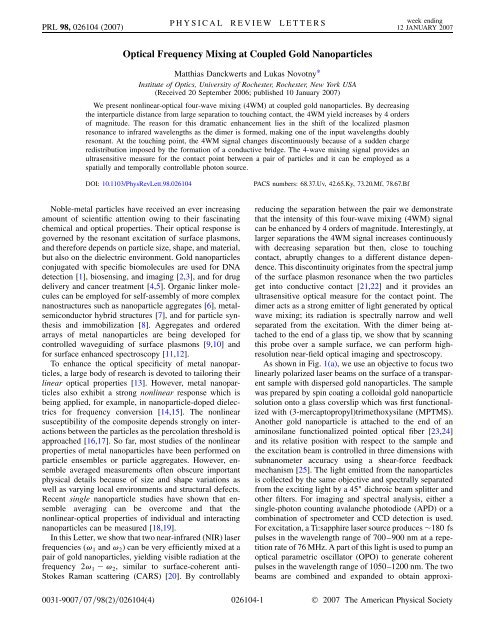
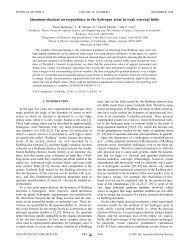
![Phase retrieval algorithms: a personal tour [Invited] - The Institute of ...](https://img.yumpu.com/25023725/1/190x249/phase-retrieval-algorithms-a-personal-tour-invited-the-institute-of-.jpg?quality=85)
